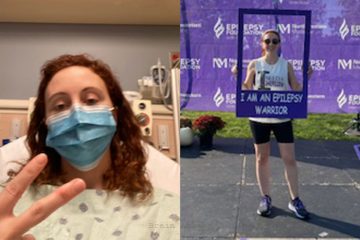I recently came across these notes. On the third year anniversary of my neurosurgery, I thought I would share them.
A few months after having resection neurosurgery in 2017, my neurologist asked me to tell my story to the incoming class of students at Stanford Medical School. The theme was “Living With Epilepsy”. On December 21, 2017, I created the following document as an overview of what I planned to speak about. I later shared it with my Neurologist as a heads up regarding what I was planning to speak.
The presentation was actually quite productive, as each time I performed it over the next few years, there was a three-fold increase in the number of students entering the Neurology track.
The document is provided as it was written except the names of the medical professionals involved have been obfuscated to ensure their privacy.
This presentation was extremely influential to the creation of Brain Ablaze. Links have been added to existing Brain Ablaze content, so the reader can learn more.
— David Clifford
Introduction
(v1) This document contains the proposed script for the talk I am supposed to do in January.
Nomenclature
Anything in brackets [] is considered notes for the reader and is not to be said during the talk.
Content
I wanted to thank you all for coming today. I recognize a lot of faces out there. I really appreciate being invited to talk today. It has been a long time since I have been in a room with so much kinetic ambition and potential to change people’s lives.
When Dr. L. originally asked me to talk about Living with epilepsy, I was actually surprised. Since I was diagnosed with epilepsy at sixteen years old, I really didn’t live with Epilepsy but endured, hid, and ignored it. Every couple of years something scary would force me to think “You know, I really should look into this”. So, I would find a neurologist go through the necessary tests and take some medication. The scans and tests would show that nothing was physically wrong with me, the medications would not work, and I would go back to hiding my symptoms. It wasn’t until I came to Stanford, that you all solved the problem.
After about a year of testing, the team here at Stanford narrowed down where my in my brain my seizures were starting and last August I underwent a Right Anterior Lobectomy. I have been seizure-free since. Which is quite remarkable because before the surgery I was averaging a tonic-clonic seizure once every three days.
If you all would indulge me, I would like to introduce to you some of the team that changed my life. When you hear your name, if you feel comfortable, I would love for you to stand up (by the way this is in no particular order all of them helped):
- My wife, Svetla
- Dr. L.
- Dr. S.
- Dr. G.
- Dr. F.
- M (Neurology Nurse Practitioner)
- V (Attaches the EEG sensors)
- K (Nurse Practitioner for Dr. S.)
For each person standing, there are at least ten other people that I haven’t called out. A lot of them are also in this room. Can we give them all a round of applause?
[Hopefully, people will clap.]
Thank you, everyone that isn’t a doctor, may I ask you sit down?
[Everyone sits down]
Thank you. Thank you.
[To the Doctors] OK doctors, can you indulge me by closing your eyes and touching your nose with your right index finger? … [Laughing] Just Kidding!
[To the Crowd] They have been doing that to me for a year now, I just couldn’t resist.
[Back to the Doctors] Please sit. Please sit. Thanks.
[The Doctors Sit]
Before coming to Stanford, it was easier for me than most epileptics to hide my symptoms, because I wasn’t what was called a “drop epileptic”, or a person that has no clue that a tonic-clonic seizure is coming and just drops to the floor.
I was actually having multiple types of seizures, but when I had a tonic-clonic seizure there were three distinct parts: a BEFORE, a DURING, and an AFTER.
About five minutes BEFORE a seizure, I had an aura. Emotionally, I would start to have lonely sensation that I can only describe as that feeling one might have when walking down a dark street in a forest when you say to yourself “This is creepy!” Physically, I started sweating like I was in the shower. I would also start rapidly swallowing and blinking. My tongue would also start tingling as if I was holding a 9-Volt battery to it like I would do when I was kid.
DURING a seizure, I didn’t feel anything. [Smiling] No bright lights. No voices speaking unfolding the secrets of the universe. My seizures lasted anywhere from tens of seconds to several minutes.
When I did wake up AFTER a seizure, I was woozy, exhausted and in pain. In my youth, I was a pretty good triathlete. [Pointing at my belly and smiling] I know right? This is what a quarter of a century of software engineering will do to you.
The exhaustion I felt after just a minute seizure is comparable to the feeling I had after racing a full international distance race. The pain right after a seizure is so intense that while laying in a bed the sheets actually hurt where they touched my skin. That pain does die down after a while though. When I started moving around I’d find pain in muscles that I didn’t know that I had. In my twenties, I was just able to jump back up after having a seizure, somewhere in my thirties it started taking about twenty four hours to just recuperate.
This actually led to yet another way I ignored the symptoms of my epilepsy. I was always honest with my employers. They knew that I was an epileptic and I would make a deal with them that I just would call in sick if I needed to recuperate.
So after years of ignoring the problem, what happened to bring me to Stanford? … Well, my WIFE.
In 2015, I had a Status Epilepticus event that scared us both to the point where she dragged me kicking and screaming into Dr. L’s office. After years of working with other doctors, taking medications that did nothing, and performing scans that had shown nothing wrong, I may have had a chip on my shoulder in my first appointment with Dr. L. I have since apologized to her in private, but I want to take this moment in front of these people to say that I am sorry. [To Dr. L] You were absolutely correct, and I was absolutely wrong.
After performing an MRI in early 2017, Dr. L found that there was a legion in my brain. I’ll let Dr. L give you the details if you’re interested … [Smiling] I have to admit that I had the opposite reaction that most people might have when they are told that they have “massive centralized brain damage”, I celebrated like Tom Brady [pronounced “Twomb Bradee”] after winning the Super Bowl — the ones in which he didn’t cheat. After years of dealing with the random symptoms of this disorder, I had hard facts concerning a REAL physical cause of the problem.
The next step was to work with Dr. G. in the Epilepsy Unit here at Stanford to determine if this legion was actually the real cause. In the EU, I was attached to a series of sensors (EEG, EKG, etc.) and videotaped around the clock with the hope to record what was going on with my brain BEFORE, DURING, and AFTER a seizure. During my five day stay, the EU technicians were able to record three different seizures. One was a pretty serious Tonic-Clonic seizure.
Doctors G. and L. presented that the EU results lined up perfectly with the MRI results. Simply put, the seizures started from the area around the legion.
If I remember correctly, my question to Dr. L was “What does the region around the legion do?” Her answer was, “Usually, it is around memory. Everyone is a bit different.” My wife tells me that about five minutes later I asked Dr. L. again, “So, what does the region around the legion do?”
The doctors at Stanford’s Cognitive Science Center were able to map what skills were actually in that region through a series of ”simple tests”. I remember that some of the tests regarding memory I just couldn’t get correct. I felt so poorly about my results, that I feared reviewing them in my next appointment with Dr. L. When she greeted me in that appointment, she exclaimed “Wow! You must be really smart! You scored just BELOW average in intelligence on these Cognitive Science tests.” After exchanging confused glances with my wife, I asked Dr. L. “How is scoring below average good?”. Dr. L. responded cheerfully, “Oh, believe me, on the dosage of medication you are taking right now these results look fantastic!”
At this point, the MRI, EU, and Cognitive Science results from all showed that the best route to improving my life was surgery. I have to admit, I was quite scared about surgery. I had thoughts of someone opening me up like a Halloween pumpkin and scooping the yucky internals. I became more open to the idea of surgery after talking to Dr. L., and she referred me to the neurosurgery department. I was immediately impressed with my neurosurgeon, Dr. S., the moment I met him. [Pointing to me head] If anyone was going to turn this pumpkin into a jack-o-lantern, I knew he was going to be my best bet.
— This is what I have so far —



0 Comments